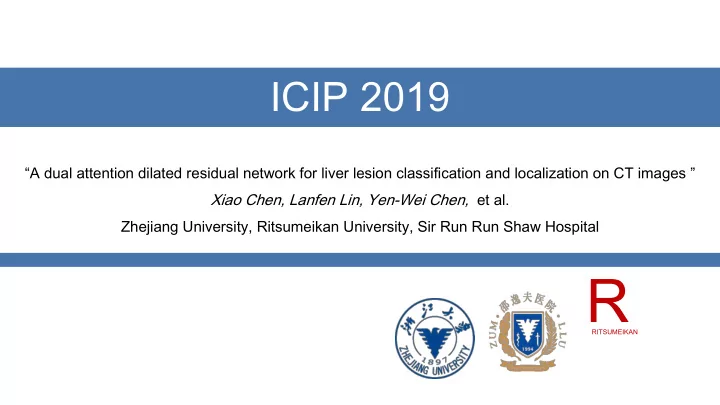

ICIP 2019 Residual Convolutional Neural Networks with Global and Local Pathways for Classification of Focal Liver “A dual attention dilated residual network for liver lesion classification and localization on CT images ” Lesions Xiao Chen, Lanfen Lin, Yen-Wei Chen, et al. Zhejiang University, Ritsumeikan University, Sir Run Run Shaw Hospital R RITSUMEIKAN
Introduction 1 Methodology Content 2 Experiments 3 Conclusion 4
Introduction Backgrounds Liver cancer is the second most common cause of cancer-related deaths among men and sixty among women. Major concern limits automatic liver lesion classification is that previous methods are conducted on lesion level, which relies heavily on ROI selection process. ROI selection Labor-intensive Automatic lesion Manual annotations detection/segmentation
Motivation To relieve the burden of expensive pixel-level lesions’ annotations, we first explored the potential of using the whole liver slice image for liver lesion classification without pre- detection or pre-selection of the ROI. Previous methods: 1. segment liver lesions 2. conduct lesion-level classification (ROI-level, patch-level, or both) Our proposed methods: 1. segment whole liver area 2. conduct image-level classification ART Phase (without lesion detection or segmentation)
Motivation Contributions Our proposed DADRN framework no longer relies on lesion annotations and could tackle the lesion classification problem as a one-stage process. Our dual-attention mechanism integrates similar features of high-level feature map from a global view, which improves DRN’s lesion recognition performance The experimental results show that DADRN is comparable to the ROI-level classification model and is superior to other state-of-the-art attention-based classification models in lesion classification task and weakly- supervised lesion localization task.
Motivation Related Work Ø Attention mechanism in Computer Vision Squeeze-Excitation block[1] (1) explicitly model channel-interdependencies within modules C*C HW*HW C*HW HW*C1 conv(1*1) Dual conv(1*1) C1*HW HW*C Attention C*HW HW*C conv(1*1) conv(1*1) block[2] reshape C*HW reshape HW*C a. spatial attention block b. channel attention block (2) model long-range dependencies and capture concurrent features within modules [1] Hu, Jie, Li Shen, and Gang Sun. "Squeeze-and-excitation networks." Proceedings of the IEEE conference on computer vision and pattern recognition. 2018. [2] Wang, Xiaolong, et al. "Non-local neural networks." Proceedings of the IEEE Conference on Computer Vision and Pattern Recognition. 2018.
Motivation Related Work Ø Closer look to dual attention block Step1: Batch matrix multiplication HW*HW HW*C1 conv(1*1) conv(1*1) Step2: Normalize similarity map C1*HW C*HW reshape conv(1*1) conv(1*1) C*HW Step3: Synthesize new feature map a. spatial attention block [1] Step4: Adaptively learn the weight of synthesized feature map b. Illustration of step1 batch matrix multiplication [1]: Wang, Xiaolong, et al. "Non-local neural networks." Proceedings of the IEEE Conference on Computer Vision and Pattern Recognition. 2018.
Introduction 1 Methodology Content 2 Experiments 3 Conclusion 4
Methodology Overview of my research
Methodology Backbone Network Ø Dilated Residual Network (DRN) (Yu et al. 2017) DRN is chosen as the backbone classification network. Since the output of Group5 in DRN is 28*28, which is much larger than that of original Resnet.
Methodology Visualization of Attention Maps Ø Gradient-weighted Class Activation Maps (Grad-CAM ) ( Selvaraju et al. 2017) Ø ) Guided Backprop ◉ classification input Guided Grad-CAM
Introduction 1 Content Methodology 2 Experiments 3 Conclusion 4
Experiments Dataset Type Train Validation Test Total Set1 Set2 Set1 Set2 Set1 Set2 Normal 135 126 41 57 51 44 227 CYST 168 166 56 59 69 68 293 FNH 75 75 29 27 26 28 130 HCC 149 143 52 57 50 51 251 HEM 112 114 38 37 40 39 190
Experiments Comparison to other methods Classification performance comparison with other attention-based CNN, baseline DRN, state-of-the-art ROI-level lesion classification method (ResGLNet). 1. Comparison of class-wise classification accuracy Method Normal CYST FNH HCC HEM DRN50 [18] 0.9788 0.9327 0.7596 0.8427 0.5278 SEResnet50[14] 0.9334 0.9327 0.7788 0.9116 0.5917 RAResnet50[13] 0.9675 0.9182 0.7596 0.8227 0.5556 1 SADRN50-A 0.9577 0.9096 0.8132 0.8816 0.6625 SADRN50-B 0.9334 0.8761 0.7775 0.8220 0.5458 CADRN50-A 0.9675 0.9551 0.8530 0.9016 0.6181 1 CADRN50-B 0.9588 0.9413 0.8324 0.8322 0.5847 2 DADRN50-A 0.9690 0.9451 0.7802 0.8024 0.7069 DADRN50-B 0.9804 0.9551 0.8159 0.9116 0.6819 ResGLNet [21] - 0.9615 0.8405 0.8846 0.8462 ① Different normalization strategy in dual attention block: sigmoid(A) softmax(B) ② Different fusion strategy of spatial and channel attention: sum fusion(A) concatenate fusion(B)
Experiments Comparison to other methods Comparison of 5-class overall classification performance Method Accuracy F1 Precision Recall DRN50 [18] 0.8083 0.8197 0.8294 0.8207 SEResnet50 [14] 0.8296 0.8265 0.8552 0.8149 RAResnet50 [13] 0.8047 0.8041 0.8304 0.7905 SADRN50-A 0.8463 0.8372 0.8346 0.8449 CADRN50-A 0.8506 0.8263 0.8149 0.8591 DADRN50-A 0.8446 0.8213 0.8111 0.8407 DADRN50-B 0.8690 0.8412 0.8528 0.8386
Experiments Comparison to other methods Weakly-supervised localization performance comparison with the state-of-the-art attention-based CNN and baseline DRN. Method CYST FNH HCC HEM DRN50 [18] 0.5110 0.6676 0.5941 0.3798 SEResnet50 [14] 0.1898 0.0742 0.7327 0.2532 RAResnet50 [13] 0.2628 0.0742 0.6931 0.3292 DADRN50-B 0.5986 0.6676 0.7327 0.5064 (a) Grad-CAM map of DRN; (b) Grad-CAM map of DADRN; (c) weakly-supervised localization result generated by (b); (d) ground truth of each slice image.
Introduction 1 Methodology Content 2 Experiments 3 Conclusion 4
Conclusion Dual attention module improve DRN’s lesion recognition ability DADRN is comparable to state-of-the-art ROI-level classification method and is superior to most state-of-the-art attention-based methods in lesion classification task and weakly-supervised lesion localization task. In future, we are going to develop a 3D attention-based network for 3D CT volumes to improve the classification accuracy. In addition, building a large scale liver lesions dataset remains a challenging task.
T ? hank you R RITSUMEIKAN
Recommend
More recommend